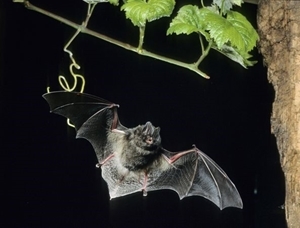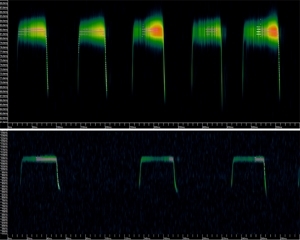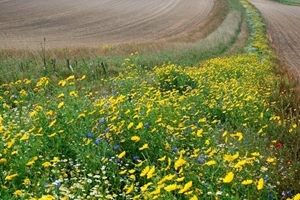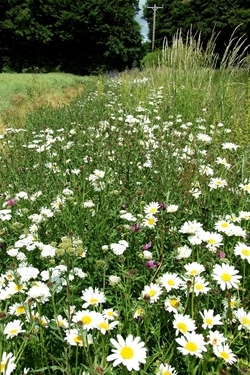Key points
- In Europe, agri-environment schemes (AES) are habitat management schemes that have been designed to provide suitable habitat for farmland wildlife.
- Bats have lost habitat on farmland, so it is important to understand how they are affected by AES.
- This study looked at how the plant structure of four common types of AES affected the presence and activity of bats.
- The study identifies ways to manage this AES habitat that could be included in current schemes to help support specific species.
- This study also highlighted the importance of developing AES that provide a variety of habitats where bats can feed. Such AES could benefit more wildlife species.
Background
 Across Europe, agriculture is the main land use. As agriculture has intensified, many areas such as woodlands and hedgerows have been removed to make farmland more open. Before being incorporated into productive farmland, these areas were important habitats for wildlife. Those that remain still provide farmland species including bats, birds and insects with places to nest, roost, and feed.
Across Europe, agriculture is the main land use. As agriculture has intensified, many areas such as woodlands and hedgerows have been removed to make farmland more open. Before being incorporated into productive farmland, these areas were important habitats for wildlife. Those that remain still provide farmland species including bats, birds and insects with places to nest, roost, and feed.
Agri-environment schemes (AES) have been developed for many reasons. One of these is to encourage wildlife-friendly farming by providing landowners with financial support for conservation. An area of farmland that is commonly managed under AES to support wildlife is the field margin, which are the strips of unfarmed land along the edges of fields. Some AES are designed to increase the diversity of flowers in field margins. In turn, this can lead to an increase in the number of insects available for birds to eat. The authors thought this would also benefit bats, particularly if the AES are near hedgerows, which bats use as travel corridors.
This study looked at how the plant structure of common AES habitat types affected the presence and activity of bats. It is important to understand the impact of AES on bats, because they have been affected by habitat loss on farmland.
What they did
This study took place on farms in southern England (Wiltshire, Hampshire and Dorset) that contained at least three of the following AES habitats:
- Grass margins – Grass areas at the edge of fields. They are intended to protect nearby habitats (e.g. rivers or hedgerows) from farming chemicals.
- Wildflower margins – Field margins that contain wildflowers (e.g. yarrow) and grasses (e.g. common bent) that provide habitat and feeding areas for insects and birds.
- Wild bird seed plots – Areas of field that contain seed-bearing plants (e.g. sunflower) that provide food for wild birds in winter.
- Pollen and nectar plots – Field margins sown with nectar rich flowers (e.g. clover) and perennial wildflowers (e.g. black knapweed) that provide food for insects that eat pollen and nectar.
 Between April and September 2017, three bat surveys were carried out on each farm.
Between April and September 2017, three bat surveys were carried out on each farm.
Bats use echolocation to navigate and hunt in the dark by bouncing high-pitched calls off their surroundings. In this study, the calls of bats flying along field boundaries were detected and recorded with a bat detector. The recordings of bat calls were identified by species or species group and the number of each was calculated. Bat presence was also recorded for each survey.
Plant surveys were carried out in each type of AES habitat. In each small survey area, the authors counted the number of plant species, the percentage covered by different types of plants or bare ground, and the number of flowering plants. The authors also estimated the average plant height at the field boundary.
The authors investigated the relationship between bat species activity and the plant measurements taken from each type of AES field margin.
What they found
 When the authors compared each type of AES, they found that there was a lot of overlap between the structure of the plants. Generally, the wildflower margins (see point 2 above) and pollen and nectar plots (4) had the highest number of flowering plants. The diversity of plants was lowest in the grass margins (1), and these margins also had highest percentage of grass cover.
When the authors compared each type of AES, they found that there was a lot of overlap between the structure of the plants. Generally, the wildflower margins (see point 2 above) and pollen and nectar plots (4) had the highest number of flowering plants. The diversity of plants was lowest in the grass margins (1), and these margins also had highest percentage of grass cover.
There are 18 species of bat in the UK, and more than six of these were detected in this study. Britain’s most common bat species is the common pipistrelle, and it accounted for 71% of the recordings in this study. The common pipistrelle and two other species – soprano pipistrelle and barbastelle – were detected often enough to be included in analysis of bat activity. Some other bat species were only detected enough to analyse the chances of them being present in an area in relation to different AES habitats.
The importance of plant and habitat characteristics varied between the different bat species.
The activity of barbastelle and soprano pipistrelles decreased in areas further away from woodland. The activity of these two species increased as plant diversity increased in the AES habitat. Barbastelle activity also increased as the number of flowering plants in the field margin increased.
The activity of common pipistrelles was most influenced by the field boundary features. Their activity increased as the boundary height and number of trees increased.
What does this mean?
 This study found that as the plants in different AES habitats grow and became established, the plant communities became more similar to one another. This means that investigating relationships between bat activity and habitat characteristics (e.g. plant diversity or hedgerow height) might be more useful than investigating the relationship between bat activity and specific AES habitats.
This study found that as the plants in different AES habitats grow and became established, the plant communities became more similar to one another. This means that investigating relationships between bat activity and habitat characteristics (e.g. plant diversity or hedgerow height) might be more useful than investigating the relationship between bat activity and specific AES habitats.
That being said, two of the AES options had characteristics that were obviously beneficial for bats. The pollen and nectar plots (4) and wildflower margins (2) had the highest diversity of plants and greatest number of flowering plants compared to the other AES habitats. This is because these two AES options were sown with lots of flowering plants, which attract pollinators as well as other insects. This meant there was more food available for bats in these habitats. This could explain why there was an increase in barbastelle and soprano pipistrelle activity in habitats with high plant diversity and lots of flowering plants.
An increase in insect numbers might also explain why the pipistrelle bat species showed higher activity near tall hedgerows and trees. Tall hedgerows provide shelter to insects, particularly flies and midges, which are the preferred food of pipistrelles. The shelter provided by tall trees and hedgerows may also help these small bats to conserve energy because their small size makes them sensitive to wind.
The activity of soprano pipistrelle and barbastelle species was also higher in field margins that were closer to woodland. Another bat species, the common noctule, was more likely to be present in field margins if there were buildings close by. Woodland and buildings both provide bats with roost sites, which are protected in England. With this in mind, the distance between roost sites and AES habitats is something that should be considered if AES are going to be implemented for bats in the future.
Overall, this study showed that plant structure and habitat characteristics of AES margins were important factors affecting bat presence and activity. This study demonstrated the importance of developing AES that provide a variety of foraging habitats for bats within the landscape. Current AES management policies are primarily designed to support bird, insect and arable plant populations, but if a wide range of species are to benefit then bats should be considered too.
Read the original abstract
McHugh, N.M., Bown, B.L., Hemsley, J.A., & Holland, J.M. (2019). Relationships between agri-environment scheme habitat characteristics and insectivorous bats on arable farmland. Basic and Applied Ecology, 40: 55-66.